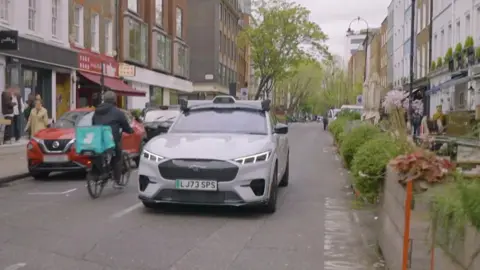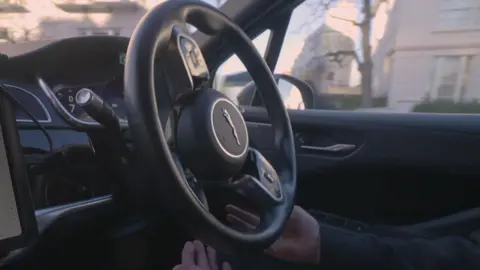 BBC
BBCUber has said it is “ready to go” now with driverless taxis in the UK – but the government has put back the date it expects to approve fully self-driving vehicles.
The previous administration said fully autonomous cars were “set to be on roads by 2026”, but the new government says it is now more likely to happen in the second half of 2027.
While limited self-driving technology is already permitted on UK roads, a human driver must be at the wheel and responsible for the vehicle, even if automated technology is being used.
With some companies trialling more advanced tech on British streets, I took an automated car ride across central London in a car using a system developed by UK AI firm Wayve.
“We’re ready to launch robotaxis in the UK as soon as the regulatory environment is ready for us,” said Andrew Macdonald, senior vice president of mobility at Uber, who joined me for the ride.
The ride-hailing firm is working with 18 automated car tech companies including Wayve.
It is one of several companies which already offers robotaxis in the US.
They are also on the roads in China, the UAE and Singapore.
But Mr Macdonald disagreed that the UK was behind the rest of the world, arguing that the US and China were ahead largely because that is where the majority of the tech had been developed.
“We are working quickly and will implement self-driving vehicle legislation in the second half of 2027”, the Department for Transport said in a statement.
“We are also exploring options for short-term trials and pilots to create the right conditions for a thriving self-driving sector,” it added.
‘Hands-off’ experience
In the US, Mr Macdonald said robotaxis typically operate for 20 hours per day, seven days per week.
Even though there is no driver to pay, Uber says the fare is currently the same as a ride with a human behind the wheel.
The option to take one appears on the app if one is available, and customers can opt in or out.
That’s partly because, aside from the regulatory environment, another potential barrier to their uptake is the public’s reticence about travelling in a self-driving vehicle.
A poll by YouGov in 2024 suggested that 37% of Brits would feel “very unsafe” travelling in a car without a driver.
But Mr Macdonald insisted new customers’ initial nervousness was short-lived and the experience soon “becomes the new normal”.
That was certainly my experience during our ride.

I was in a Ford Mach-e, fitted with Wayve’s autonomous driving sensors and software.
It uses a radar and seven cameras. In the boot there’s is a computer which is running the AI-driven software that processes all that sensor data in real time and controls the car’s responses.
The automated tech handled every scenario without a hitch, including pedestrians in the road, parked cars, heavy traffic, temporary traffic lights and delivery bikes.
George, our safety driver, did not touch the controls once and a big red button, which shuts off the automated system immediately, was not deployed.
If anything the robo-ride was a far more patient city driver than I am – and has no voice, making it a lot less chatty.
Whether autonomous vehicles are more or less safe than human-driven ones is still being investigated.
But numerous studies suggest that automated vehicles are less accident-prone than human drivers, based on US data.
But there have been a number of incidents involving robotaxis in the countries where they operate, ranging from road accidents to passengers being locked in.
In January, a man in Arizona, in the US, documented how his robotaxi drove round in circles in an airport carpark, with him trapped in the vehicle, unable to stop the car or get help.
General Motors paused its driverless taxi service Cruise in San Francisco in 2023 because of safety concerns.
“The reality is that one accident is too many,” said Uber’s Mr Macdonald.
“That said, with EV (electric vehicles), human drivers… we operate in the real world and stuff happens.”
In the UK there are also practical questions around insurance, ownership and liability when a self-driving vehicle is involved in an accident. Mr Macdonald said they were all still being worked out.

Tom Leggett, vehicle technology manager at Thatcham Research – an independent car safety centre – said robotaxis would have to be “safety-led” in the UK.
“Secondly, they will have to make sure the data is available to those who need it – insurers and those investigating incidents when they occur.”
The government says self-driving vehicles have the potential “to build an industry worth £42bn and provide 38,000 jobs by 2035.”
But of course they are source of concern for people who earn a living driving.
Andy Prendergast, GMB national secretary, said the “significant social implications” driverless cars and taxis could have – such as potential less work or unemployment – for workers and the public must be fully considered.
Uber’s Mr Macdonald meanwhile believes automated vehicles will transform the way many people travel in the near future.
“I’ve got young kids,” he said.
“Do I think my daughters will necessarily get their drivers licences when they turn 16?” [the legal age in his home country, Canada].
“No – I think the world is changing a lot.”
Additional reporting by Liv McMahon


